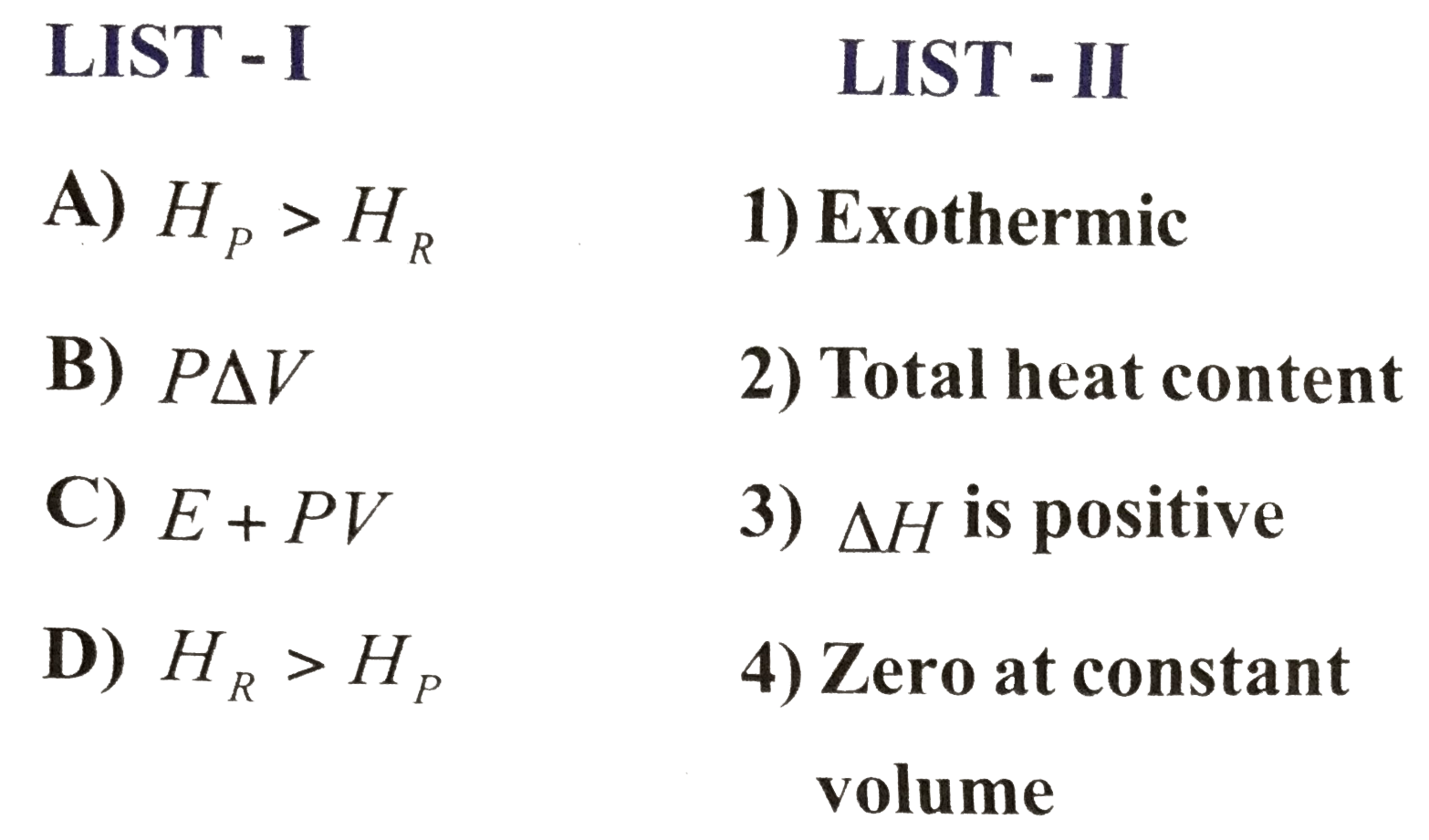ΔG is a thermodynamic prop erty the decrease in which value is the measure of useful work done at constant temperature and pressure:
ΔGsystem<0 (spon tan eous) ,
ΔGsystem=0 (equilibrium),
ΔGsystem>0 (non- spon tan eous),
Free energy is related to the equilibrium constant, as ΔG∘=−2.0303RTlog10Kc
For a reaction to be spontaneous at all temperatures:
ΔG−ve,ΔH+ve and ΔS+ve
ΔG+ve,ΔH−ve and ΔS+ve
ΔG−ve,ΔH−ve and ΔS−ve
ΔG−ve,ΔH−ve and ΔS+ve
The correct Answer is:D
Step by step video, text & image solution for DeltaG is a thermodynamic prop erty the decrease in which value is the measure of useful work done at constant temperature and pressure: DeltaG_("system") lt 0 (spon tan eous) , DeltaG_("system")=0 (equilibrium), DeltaG_("system") gt 0 (non- spon tan eous), Free energy is related to the equilibrium constant, as DeltaG^(@)=-2.0303 RT log_(10) K_(c) For a reaction to be spontaneous at all temperatures: by Chemistry experts to help you in doubts & scoring excellent marks in Class 11 exams.
Updated on:21/07/2023Topper's Solved these Questions
- THERMODYNAMICSBOOK - NARAYNACHAPTER - THERMODYNAMICSEXERCISE - Matching type
6 Videos
- THERMODYNAMICSBOOK - NARAYNACHAPTER - THERMODYNAMICSEXERCISE - Assertion- Reason
5 Videos
- THERMODYNAMICSBOOK - NARAYNACHAPTER - THERMODYNAMICSEXERCISE - Level-VI
150 Videos
- STRUCTURE OF ATOMBOOK - NARAYNACHAPTER - STRUCTURE OF ATOMEXERCISE - EXERCISE - IV EXEMPLAR PROBLEMS
24 Videos
Similar Questions

The correct match is
View SolutionAssertion (A): Internal energy change in a cyclic process is zero.
Reason (R ) : Internal energy is a state funciton.
View SolutionA certain mass of gas expanded from ( 1L, 10 atm) to (4 L, 5 atm) against a constant external pressure of 1 atm. If initial temperature of gas is 300 K and the heat capacity of process is 50J/∘C. Then the enthalpy change during the process is :
(1Latm˜–100J)
View SolutionWhich of the following conclusions couldnot be derived from Rutehrford's α-particle scattering experiment?
View SolutionIdentify the correct statement for change of Gibbs energy for a system (DeltaG_(system)) at constant temperature and pressure:
View SolutionWhich range includes the value of the equilibrium constant, Keq, for a system with ΔG∘ lt 0 ?
View SolutionDeltaG is a thermodynamic prop erty the decrease in which value is the measure of useful work done at constant temperature and pressure: DeltaG_("system") lt 0 (spon tan eous) , DeltaG_("system")=0 (equilibrium), DeltaG_("system") gt 0 (non- spon tan eous), Free energy is related to the equilibrium constant, as DeltaG^(@)=-2.0303 RT log_(10) K_(c) A reaction has poaitive values of DeltaH and DeltaS from this you can deduce that the reaction:
View SolutionThe change in Gibbs free energy of the system alone provides a criterion for the spontaneity of a process at constant temperature and pressure. A change in the free energy of a system at constant temperature and pressure will be : DeltaG_("system")=DeltaH_("system")-T DeltaS_(system") For a system in equilibrium, DeltaG=0 , under conditions of contant....
View SolutionFor a system in equilibrium, ΔG=0, under conditions of constant
View SolutionThe change in Gibbs free energy (DeltaG) of the system along provides a criterion for the spontaneity of a process at constant temperature and pressure. A change in the free energy of a system at constant temperature and pressure will be: DeltaG_("system")=DeltaH_("system")-TDeltaS_("system") At constant temperature and pressure: DeltaG_("system")lt0 (Spontaneous) DeltaG_("system")=0 (equilibrium) DeltaG_("system")gt0 (non-spontaneous) Free energy is related to the equilibrium constant as: DeltaG^(@)=2.303RTlog_(10)K_(e) . Q. If b oth DeltaH and DeltaS are negative, the reaction will be spontaneous:
View SolutionThe change in Gibbs free energy (ΔG) of the system along provides a criterion for the spontaneity of a process at constant temperature and pressure. A change in the free energy of a system at constant temperature and pressure will be:
ΔGsystem=ΔHsystem−TΔSsystem
At constant temperature and pressure:
ΔGsystem<0 (Spontaneous)
ΔGsystem=0 (equilibrium)
ΔGsystem>0 (non-spontaneous)
Free energy is related to the equilibrium constant as:
ΔG∘=2.303RTlog10Ke.
Q. A reaction has positive values of ΔHandΔS. From this you can deduce that the reaction:
View SolutionThe change in Gibbs free energy (ΔG) of the system along provides a criterion for the spontaneity of a process at constant temperature and pressure. A change in the free energy of a system at constant temperature and pressure will be:
ΔGsystem=ΔHsystem−TΔSsystem
At constant temperature and pressure:
ΔGsystem<0 (Spontaneous)
ΔGsystem=0 (equilibrium)
ΔGsystem>0 (non-spontaneous)
Free energy is related to the equilibrium constant as:
ΔG∘=2.303RTlog10Ke.
Q. For a reaction to be spontaneous at all temperature.
View SolutionIdentify the correct statement for change of Gibbs energy for a system (ΔGsystem) at constant temperature and pressure:-
View SolutionIdentify the correct statement for change of Gibbs energy for a system (ΔGsystem) at constant temperature and pressure.
View SolutionThe change in Gibbs free energy of the system along provides a criterion for the spontaneity of a process at constant temperature and pressure. A change in the free energy of a sytem at constant temperature and pressure will be: ΔGsystem=ΔHsystem−TΔSsystem
For a spontaneous reaction ΔG, equilibrium constant K and E0cell will be respectively:
View Solution

